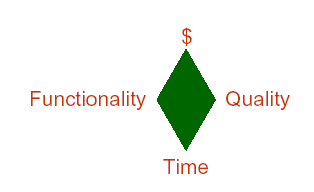WCI HOME | WCI PRESS | ABOUT WCI | CONTACT US | ROELF'S E-PUBLICATIONS | SITE MAP | |
|
|
The Project Management Institute focuses on the trade-offs among the project triad of scope, time and cost in order to frame its approach to project management. Our experience indicates that there is a fourth variable in any project management decision to be considered - quality.
As practicing project managers, and as individuals who have been asked to turn around projects in trouble, we have faced the reality of this fourth variable time and time again. A project manager can always save time and dollars by pushing quality issues into the future. In software development, this often leads to releasing software that contains "known bugs". Anyone who uses commercial software has been subjected to the results of such decisions.
|
||
|
Seven Key Project Management Ideas
An Eighth Overriding Project Reality
Project often have steering committees. Project management training (see the Project Management Institute web site for information) includes guidance for project managers on dealing with the members of such steering committees. However, little guidance exists for members of project steering committees. If you are in this role, you may find it useful to download the following guide for project steering committee members. "Handbook for New Members of Automation Project Steering Committees" Pilot or prototype projects are very different from structured automation projects. The few pages in the link below describes some of the main differences that both project managers of such projects, and members of their steering committees, need to be aware of.
|
||
| Explicit
Project Risk Assessment
Time-boxing has a second benefit. It limits the amount of risk taken at any one point in time on high risk projects. After several years of experience with explicit risk analysis for all projects, we know that such analysis is a necessary part of all project initiation. Our experience with this approach started with software development. However, we quickly learned to modify the approach to organizational change and other types of projects. Essentially, the technique applies a template of risk assessment questions to a project plan. Such templates involves scoring the project on the project on the following types of factors.
The scoring is done very quickly (days). It is best if both project leaders and project clients participate in the scoring. It can done in either survey or workshop mode. The first is faster. The second, when led by an experienced facilitator, creates a greater degree of understanding and consensus among key project individuals. The results lead to action. For each area where project risk is beyond a low or medium level, explicit risk management and mitigation activities must be part of the project plan. For any project phase where the aggregate risk level is above a low or medium level, regular risk review dialogue must occur among the project manager and the senior project clients. |
||
|
A project which does not keep track of its key input and output metrics is an unmanaged project. Even low or medium risk projects go off track with regular reporting of basic metrics. This is not the same as project accounting. Like all accounting, project accounting must track project costs accurately to the penny. It is simply a subset of fiscal accounting and must face the same rigorous accounting standards that normal accounting meets. That takes time. It often takes more time than a project has available if team members are to take effective corrective action. Project metrics therefore must meet a somewhat different standard. Project measurements must correctly predict the trend of a project's consumption of resources and the size and quality of its output. Accurate estimates are often as effective at doing this as "every transaction" accounting methods. Estimates are usually cheaper and faster to collect and to trend. Project managers on all projects need to establish (or use already existing) processes that allow them:
the following basic metrics. Everyone on the project team needs access to these metrics so that they know where the project stands. All project clients need access to the same metrics. Input metrics:
Output metrics:
|
||
|
In the past years, we have had the opportunity to work with software project management approaches that address the scope, time, cost and quality trade-offs by consciously limiting the scope of any one phase of a larger project. Called time-boxing, this approach essentially says do what you can do in 30, 60, 90 or 120 days. Focus on delivering something that has some utility to the project clients. Let them experience these results. See if they are prepared to fund the next phase of the project based on this experience. Time-boxing replicates the basic principle of limiting the available resources which has proven so successful in managing pilot projects in many other disciplines. |
||
Search this and other WCI related sites
by putting your search key words
in the box below:
© 2002 - 2013 Workplace Competence International Limited. All Rights Reserved. Terms of Use
